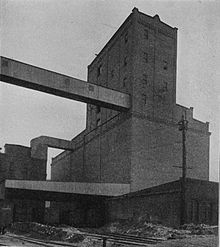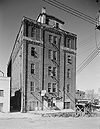
Saint Anthony Falls, or the Falls of Saint Anthony, located at the northeastern edge of downtown Minneapolis, Minnesota, is the only natural major waterfall on the Mississippi River. Throughout the mid-to-late 1800s, various dams were built atop the east and west faces of the falls to support the milling industry that spurred the growth of the city of Minneapolis. In 1880, the central face of the falls was reinforced with a sloping timber apron to stop the upstream erosion of the falls. In the 1950s, the apron was rebuilt with concrete, which makes up the most visible portion of the falls today. A series of locks were constructed in the 1950s and 1960s to extend navigation to points upstream.

The Duluth, Missabe and Iron Range Railway (DM&IR), informally known as the Missabe Road, was a railroad operating in northern Minnesota and Wisconsin that used to haul iron ore and later taconite to the Great Lakes ports of Duluth and Two Harbors, Minnesota. Control of the railway was acquired on May 10, 2004, by the Canadian National Railway (CN) when it purchased the assets of Great Lakes Transportation.

The Pillsbury A-Mill is a former flour mill located on the east bank of the Mississippi River in Minneapolis, Minnesota. It was the world's largest flour mill for 40 years. Completed in 1881, it was owned by the Pillsbury Company and operated two of the most powerful direct-drive waterwheels ever built, each capable of generating 1,200 horsepower . In 1901 one of the turbines was replaced with a 2,500 horsepower one. Both the mill and its headrace tunnel are contributing resources to the St. Anthony Falls Historic District, which is on the National Register of Historic Places. The mill is also independently on the NRHP. The mill was named a National Historic Landmark in 1966 and has since been converted into the A-Mill Artist Lofts.
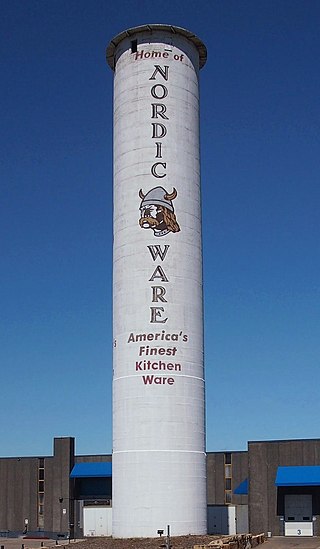
The Peavey–Haglin Experimental Concrete Grain Elevator is the world's first known cylindrical concrete grain elevator. It was built from 1899 to 1900 in St. Louis Park, Minnesota, United States, as an experiment to prove the design was viable. It was an improvement on wooden elevators that were continually at risk of catching fire or even exploding. Its cylindrical concrete design became the industry standard in the United States, revolutionizing grain storage practices. After its initial experiments, the Peavey–Haglin Elevator was never again used to store grain. Since the late 1960s it has been maintained on the grounds of the Nordic Ware company and is painted with their name and logo.
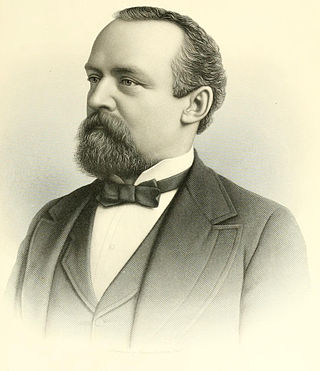
Charles Alfred Pillsbury was an American businessman, flour industrialist, and politician. He was a co-founder of the Pillsbury Company.

Phelps Mill is a flour mill in Otter Tail County, Minnesota, United States, on the Otter Tail River. The mill was built in 1888–1889 by William E. Thomas, a local entrepreneur who owned a flour and feed business in Fergus Falls. During that time, wheat was a high-demand crop, and nearly one thousand flour mills were in operation throughout Minnesota. Thomas began constructing a wooden dam on the river in the spring of 1888, although the dam was prone to leakage and had to be shored up with sandbags, dirt, gravel, and other materials. The mill itself was built by Royal Powers, who built and framed the mill without using blueprints. He was able to keep the entire plan within his head and did not even have to mark out the lumber he was cutting.

Minneapolis is the largest city by population in the U.S. state of Minnesota, and the county seat of Hennepin County. The origin and growth of the city was spurred by the proximity of Fort Snelling, the first major United States military presence in the area, and by its location on Saint Anthony Falls, which provided power for sawmills and flour mills.

Charles Morgridge Loring was an American businessman, miller and publicist. Raised in Maine to be a sea captain, Loring instead became a civic leader in Minneapolis, Minnesota where he was a wealthy flour miller and in Riverside, California where he helped to build the first city hall. He was a popular and generous man who enjoyed many friendships and business associations.

Northwestern Consolidated Milling Company Elevator A also known as the Ceresota Elevator and "The Million Bushel Elevator" was a receiving and public grain elevator built by the Northwestern Consolidated Milling Company in 1908 in Minneapolis, Minnesota in the United States. The elevator may have been the largest brick elevator ever constructed and ran on electricity. The elevator was the source for the Crown Roller Mill and Standard Mill. Those mills closed in the 1950s but the elevator continued in use for grain storage until the mid 1980s. The building is a contributing property of the St. Anthony Falls Historic District listed in the National Register of Historic Places in 1971. For this article north is toward the river.

The North Star Woolen Mill, now the North Star Lofts, is a building in downtown Minneapolis, Minnesota, United States. The building, located in the St. Anthony Falls Historic District, was originally a textile mill for the North Star Woolen Company. The mill was built in 1864 by W.W. Eastman and Paris Gibson on the west side of the west side canal. High quality wool blankets, scarves, flannels, and yarns were manufactured at the facility and it became the nation's largest manufacturer of wool blankets by 1925.
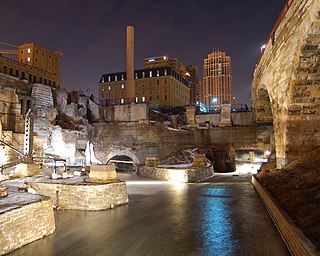
Mill Ruins Park is a park in downtown Minneapolis, Minnesota, United States, standing on the west side of Saint Anthony Falls on the Mississippi River and running from 3rd Ave. S. to about 9th Ave. S. The park interprets the history of flour milling in Minneapolis and shows the ruins of several flour mills that were abandoned.

The following are all the contributing resources to the Saint Anthony Falls Historic District in Minneapolis, Minnesota, United States. The District is listed on the National Register of Historic Places, thus these properties are on the NRHP. The "period of significance" of the District was 1858–1941. The district's archaeological record is considered to be one of the most-endangered historic sites in Minnesota.

Schech's Mill is a historic mill in Houston County, Minnesota, United States. It is one of three watermills in Minnesota still operating solely with water power and the only one to have its original millstones. Built by John Blinn in 1876, it was purchased by a Minneapolis miller, Michael Schech who had emigrated from Bavaria, Germany. The mill produced cornmeal, rye buckwheat, wheat flour, graham flour, and whole wheat cereal, which was sold in Caledonia and Houston, Minnesota. Schech's Mill is unique in the state for retaining intact and operable machinery from the 1870s, after the middlings purifier had been introduced but before millstones were supplanted by roller mills. In 1922, a concrete dam was built to replace the original wooden one.

Mill City Museum is an American Minnesota Historical Society museum in Minneapolis. It opened in 2003 built in the ruins of the Washburn "A" Mill next to Mill Ruins Park on the banks of the Mississippi River. The museum focuses on the founding and growth of Minneapolis, especially flour milling and the other industries that used hydropower from Saint Anthony Falls.

The Great Northern Elevator was a grain storage facility at 250 Ganson Street in Buffalo, New York. The elevator was located on the City Ship Canal and at the time of its completion in 1897, the elevator was the world's largest. The elevator was the first to employ cylindrical steel bins for grain storage, and also one of the first to run on electricity. The brick curtain wall did not support the bins or the working house and was designed as weatherproofing only.

William Hood Dunwoody was an American banker, miller, art patron and philanthropist. He was a partner in what is today General Mills and for thirty years a leader of Northwestern National Bank, today's Wells Fargo.
John Sargent Pillsbury Sr. was an American businessman and industrialist known for his role as CEO at Pillsbury Company. His father was Charles Alfred Pillsbury co-founder of Pillsbury Company with his uncle John S. Pillsbury after which John himself was named. John's father had served in the Minnesota State Senate and his great uncle had served as governor of Minnesota from January 7, 1876, to January 10, 1882. It was for this reason that John had wanted to pursue a career in politics upon graduating from the University of Minnesota. He had also planned to go to France at the turn of the century to study international law and the French language.
St. Anthony Falls in Minneapolis, Minnesota, is the only natural falls on the Mississippi River. Since almost the beginning of settlement in the area by European descendants, the St. Anthony Falls have been used for waterpower. The first allowed settlers were at Ft. Snelling, where construction began in 1820. A sawmill was operating 1821 and a flour mill in 1823. As soon as the land at the sides of the falls became available it was purchased with the intent of using the waterpower of the falls. First lumber mills covered the falls, cutting lumber floated down the Mississippi. After 1870 flour mills started to dominate the area. From 1880 to 1930 the area was the number one flour producer in the US. In later years, some of the power came from steam, but in 1923 half of the waterpower used was for flour milling. Other industries have also used the waterpower.



